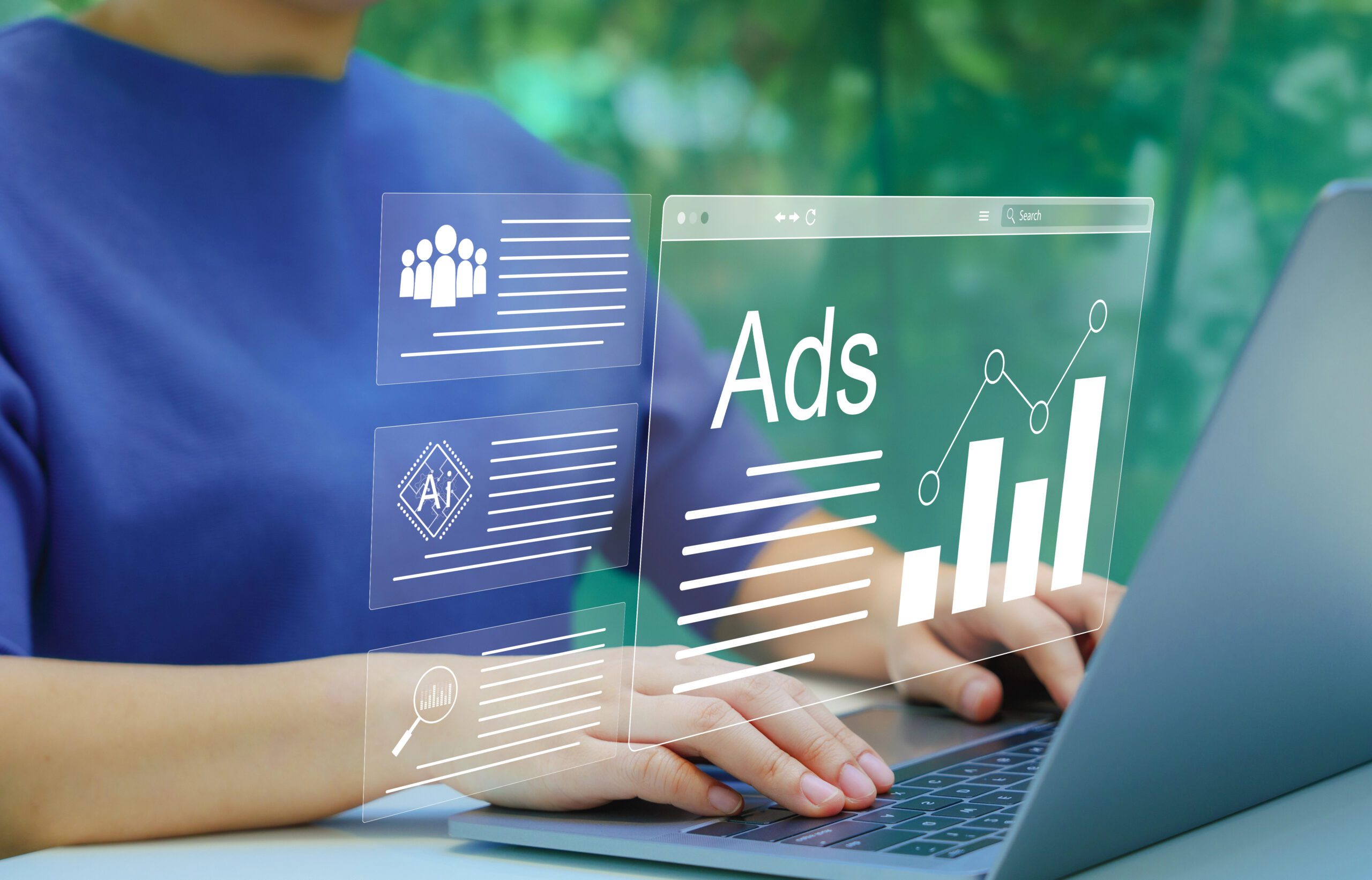The advertising industry is undergoing a seismic shift driven by rapid advancements in artificial intelligence (AI) and machine learning.
The global AI market was estimated at USD 196.63 billion in 2023 and is projected to grow at a CAGR of 36.6% from 2024 to 2030, which has a profound and far-reaching impact on advertising.
This guide explores AI’s role in reshaping advertising, from broad applications in programmatic advertising and predictive analytics to platform-specific strategies for Google, Meta, Pinterest, TikTok, and X.
We also address critical ethical considerations and privacy concerns, providing real-world case studies and actionable insights to help you navigate and thrive in the AI-powered future of paid media.
Table of Contents
- What is AI & Machine Learning?
- AI’s Role In Advertising
- Key AI Technologies in Advertising
- Broad Applications of AI in Paid Media
- Maximizing ROI with AI in Programmatic Advertising
- AI-Powered Predictive Analytics for Campaign Success
- Enhancing Engagement with AI-Driven Creative and Video Advertising
- Ethical Considerations and Privacy in AI-Driven Advertising
- Platform-Specific Applications and Opportunities
- Lessons Learned and Best Practices
- Implementing AI in Your Paid Media Strategy
- The Future of AI and Paid Media Advertising
What is AI and Machine Learning?
Definitions of Artificial Intelligence and Machine Learning
- Artificial Intelligence (AI) involves developing computer systems capable of performing tasks that typically require human intelligence, such as visual perception, speech recognition, decision-making, and language translation. AI encompasses various techniques and applications, including Machine Learning (ML).
- Machine Learning (ML), a subset of AI, focuses on creating algorithms that enable computers to learn from data and improve their performance on specific tasks over time without explicit programming. This approach is crucial for handling complex, data-intensive processes where traditional programming falls short
Types of AI and Their Applications
AI can be classified into several types, each with distinct capabilities and applications:
- Narrow AI (Weak AI): Designed for specific tasks, such as voice assistants (e.g., Siri, Alexa) and recommendation systems. Narrow AI is prevalent in everyday applications, providing highly specialized functionality.
- Artificial General Intelligence (AGI): This type of AI aims to achieve human-like cognitive abilities, allowing machines to understand, learn, and apply knowledge across various tasks. AGI remains a theoretical goal and is a major focus of ongoing research.
- Supervised Learning: Involves training algorithms on labeled data, where the input-output pairs are known. This method is commonly used in image and speech recognition.
- Unsupervised Learning: Utilizes algorithms to analyze and cluster data without labeled responses, identifying hidden patterns and relationships. It is often applied in customer segmentation and anomaly detection.
- Reinforcement Learning: Employs algorithms that learn to make decisions by receiving rewards or penalties based on their actions. This method is widely used in robotics, gaming, and autonomous systems.

AI’s Role In Advertising
AI is revolutionizing the way brands connect with consumers, enabling highly personalized and effective advertising strategies. For instance, AI-driven audience targeting has demonstrated a 30% increase in ad performance and a 25% reduction in costs. These technologies leverage big data, predictive analytics, and real-time bidding to maximize ROI.
Examples of AI Applications in Advertising
- Programmatic Advertising: Automates the buying and selling of ad space in real time, optimizing ad placements based on data-driven insights.
- AI-powered Audience Targeting: Enables highly personalized ad delivery, significantly improving engagement and conversion rates. Tools like Phrasee utilize AI to generate optimized ad copy, while platforms like Facebook automate the creation and management of ad variations
Key AI Technologies in Advertising
AI technologies are revolutionizing the advertising industry, providing new methods to enhance targeting, personalize experiences, and optimize campaign performance. Key technologies like natural language processing (NLP) and computer vision are central to this transformation, enabling advertisers to analyze and utilize data innovatively.
- Natural Language Processing (NLP): NLP enables machines to understand, interpret, and generate human language. In advertising, NLP is used for sentiment analysis, understanding consumer feedback, and generating ad copy. For example, NLP can analyze social media posts and reviews to gauge consumer sentiment toward a brand, allowing advertisers to tailor their messages accordingly. Additionally, AI-powered tools can create optimized ad copy that resonates with the target audience, improving engagement and conversion rates.

- Computer Vision: This technology allows machines to interpret and understand visual information from the world. In advertising, computer vision analyzes images and videos, enabling more effective ad placements. For example, computer vision can identify brand logos in user-generated content, allowing advertisers to target ads based on the visual context. This enhances the relevance and impact of advertisements, leading to higher engagement rates.
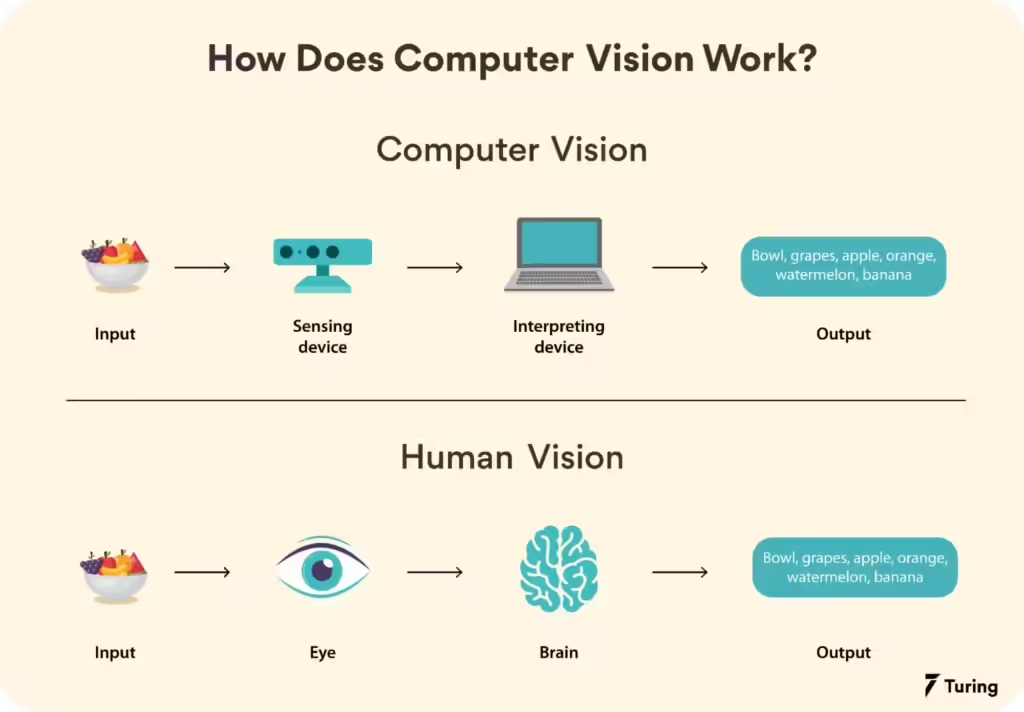
Role of Big Data in Enhancing AI Capabilities
Big data is crucial in enhancing AI capabilities in advertising. By processing vast amounts of data, AI systems can uncover patterns and insights that would be impossible for humans to detect, allowing for more accurate audience targeting and personalized advertising experiences.
- Data Collection and Analysis: AI systems collect and analyze data from various sources, including social media, browsing behavior, and purchase history. This data builds detailed consumer profiles, enabling precise audience segmentation and targeting.
- Predictive Analytics: By leveraging big data, AI can predict future consumer behavior and optimize ad campaigns in real-time. Predictive analytics allows advertisers to anticipate trends and adjust their strategies, ensuring their ads remain relevant and effective.

Examples of AI Technologies Improving Targeted Advertising
AI technologies have significantly improved targeted advertising in various ways:
- Programmatic Advertising: AI-driven programmatic advertising automates the buying and selling of ad space, optimizing placements based on real-time data. Machine learning algorithms determine the best ad placements and bids, maximizing ROI for advertisers
- Personalization: AI enables highly personalized ads that resonate with individual consumers. For instance, AI can analyze a user’s past interactions and preferences to deliver personalized product recommendations and offers, increasing the likelihood of conversion and enhancing the customer experience
- Creative Optimization: AI tools like Jacquard use machine learning to generate and optimize ad copy. By analyzing past performance data, these tools can create ad variations that are more likely to engage and convert users. This continuous optimization process ensures that ads remain effective over time
Broad Applications of AI in Paid Media
AI-Powered Audience Targeting and Personalization
AI revolutionizes how brands connect with consumers, enabling highly personalized and effective advertising strategies. For instance, AI-driven audience targeting has demonstrated a 30% increase in ad performance and a 25% reduction in costs. These technologies leverage big data, predictive analytics, and real-time bidding to maximize ROI.
Methods Used by AI to Analyze and Segment Audiences
- Natural Language Processing (NLP): Analyzes text data from customer reviews, social media posts, and other sources to gauge sentiment and preferences.
- Computer Vision: Processes visual data, such as images and videos, to identify brand logos or product usage, enabling context-specific ad targeting.
- Predictive Analytics: Enhances segmentation by forecasting future behaviors based on historical data, allowing marketers to tailor their campaigns to anticipated consumer actions.
Case Studies Demonstrating Successful AI-Driven Audience Targeting
- Booking.com: Utilized AI to enhance on-site personalization, leading to significant improvements in user engagement and conversion rates. Returning visitors saw a 65.16% increase in cart additions, a 73.72% boost in conversion rates, and spent 16.15% more per transaction.

- Procter & Gamble (P&G): Leveraged AI-powered market segmentation to optimize ad targeting and achieve remarkable financial results. By adopting a consumer-centric approach and utilizing data-driven insights, P&G increased its ROI significantly, with sales reaching $84 billion and net earnings exceeding $10 billion.

In both cases, the effective use of AI in targeting and personalization demonstrates the significant potential for AI-driven strategies to outperform traditional methods. These examples validate the efficacy of AI in enhancing audience targeting and emphasize the need for businesses to adopt advanced AI tools to remain competitive in the digital advertising landscape.
Benefits of Personalized Advertising Experiences
Personalized advertising experiences offer several benefits:
- Enhanced Engagement: Personalized ads that resonate with individual preferences are more likely to capture attention and engage consumers. AI-driven personalization ensures that ads are relevant, timely, and contextually appropriate, leading to higher engagement rates.
- Improved Conversion Rates: Tailored messages and offers significantly increase the likelihood of conversions. By addressing the specific needs and interests of consumers, personalized ads foster a deeper connection and prompt action.
- Increased Customer Loyalty: Personalized experiences build trust and loyalty by demonstrating that the brand understands and values the consumer’s preferences. This fosters a positive brand perception and encourages repeat business.
- Cost Efficiency: AI-driven personalization optimizes ad spend by targeting the most relevant audience segments, reducing wastage, and improving the overall efficiency of advertising campaigns.
Maximizing ROI with AI in Programmatic Advertising
Evolution of Programmatic Advertising and its Integration with AI
Programmatic advertising has transformed the digital marketing landscape by automating the buying and selling of ad space in real-time. This evolution began with the advent of real-time bidding (RTB) technology, allowing advertisers to bid for ad space in milliseconds.
As the industry matured, programmatic advertising integrated more sophisticated AI and machine learning technologies, enhancing efficiency and effectiveness. Today, AI drives the optimization of ad targeting, audience segmentation, and real-time campaign adjustments, ensuring that ads reach the right audiences at the right times.

Techniques for Maximizing ROI Using AI in Programmatic Ad Buys
- Predictive Creative Optimization (PCO): AI models analyze vast amounts of data to predict which ad creatives will perform best. This continuous learning process ensures that ads remain relevant and engaging, adapting to changing market trends and consumer behaviors.
- Cross-Channel Automated Optimization: Advanced algorithms improve ad performance across various channels, such as social media, search engines, and programmatic networks. By integrating insights from multiple platforms, AI ensures cohesive and effective ad strategies.
- Dynamic Personalization: AI enables ad personalization based on user attributes and behaviors. This technique ensures that ads are tailored to individual preferences, significantly enhancing engagement and conversion rates.
- Fraud Detection and Prevention: AI algorithms detect and prevent ad fraud by analyzing patterns and anomalies in ad traffic. This capability protects advertisers from wasted spend and ensures that ads reach genuine audiences.
Examples of Successful Programmatic Ad Campaigns Using AI
- Kellogg’s: Kellogg’s leveraged programmatic buying through DoubleClick Digital Marketing to deliver personalized messages to their target audience. The use of AI in their programmatic ads increased ad visibility from 56% to over 70%, demonstrating how AI can significantly enhance ad performance by optimizing creative elements and placements.
- Local Now: Local Now partnered with PubMatic to enhance their programmatic advertising efforts. By utilizing advanced AI-driven tools, they experienced a 282% year-over-year increase in revenue and a significant rise in ad requests. This case highlights the effectiveness of AI in optimizing ad strategies and driving substantial business growth.
AI-Powered Predictive Analytics for Campaign Success
How Predictive Analytics Uses AI to Forecast Campaign Outcomes
Predictive analytics utilizes AI to analyze historical data, identify patterns, and forecast future behaviors and trends. By processing vast amounts of data through machine learning algorithms, AI provides marketers with actionable insights to make data-driven decisions.
These insights help predict customer actions such as purchase likelihood, churn risk, and responses to marketing campaigns, allowing marketers to adjust strategies proactively. This continuous learning and real-time updating ensure the accuracy and relevance of predictions, which enhances campaign effectiveness.
Examples of Predictive Models Improving Ad Campaign Effectiveness
- Starbucks’ Deep Brew: Starbucks implemented an AI-driven marketing tool called Deep Brew, which uses machine learning to predict customer orders based on factors such as past purchases, time of day, location, and weather conditions. This predictive capability significantly enhanced customer engagement, leading to higher sales and increased customer loyalty by anticipating customer needs before they expressed them.
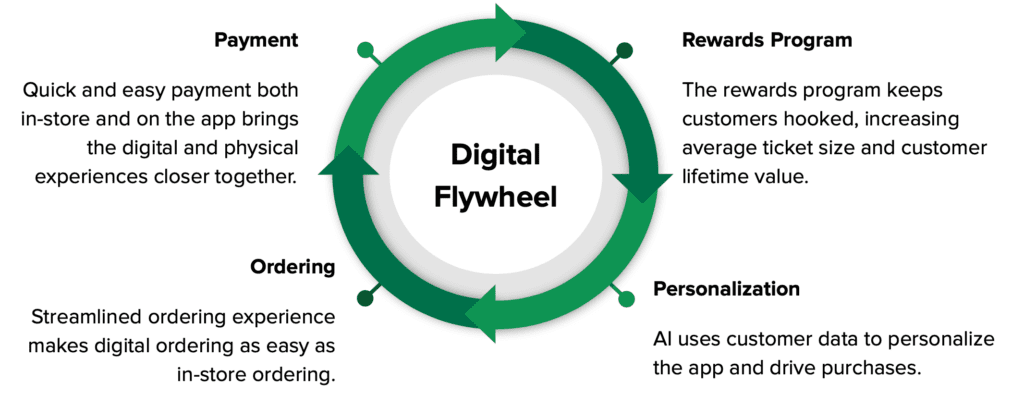
- Netflix’s Content Recommendations: Netflix employs predictive analytics to personalize content recommendations for its users. By analyzing viewing history and preferences, Netflix can predict which shows or movies a user will likely watch next. This personalized approach has dramatically increased user engagement and retention, showcasing the power of predictive analytics in enhancing user satisfaction (HubSpot Blog).
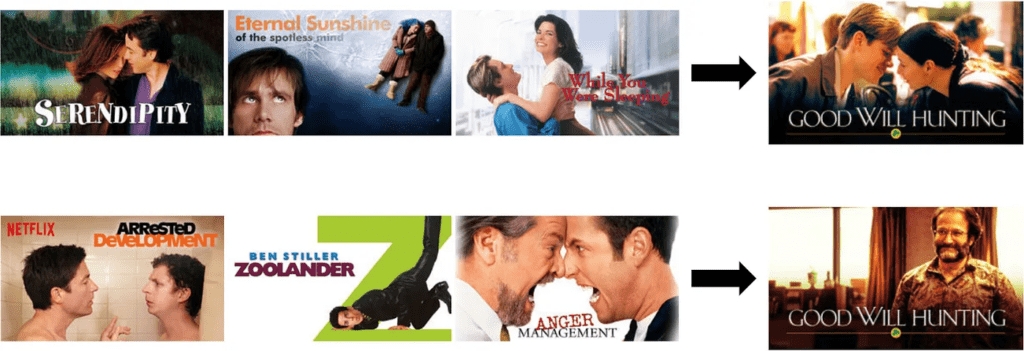
Benefits of Predictive Analytics in Adjusting Campaign Strategies in Real Time
Predictive analytics allows marketers to fine-tune their strategies in real-time based on current data, ensuring campaigns stay relevant and effective as market conditions and consumer behaviors change.
Key benefits include:
- Enhanced Targeting: Predictive models identify high-value audience segments, allowing marketers to focus on the most promising prospects.
- Improved Personalization: Understanding individual customer preferences enables marketers to tailor their messages, leading to higher engagement rates.
- Resource Efficiency: Optimizing ad spend and reducing waste through precise audience targeting enhances overall campaign efficiency.
Enhancing Engagement with AI-Driven Creative and Video Advertising
Role of AI in Creating Engaging and Dynamic Ad Content
AI significantly contributes to creating engaging and dynamic ad content by automating the creative process and personalizing messages for individual users. AI tools generate ad variations, optimize performance, and tailor content based on user interactions. This ensures that ads are always relevant and engaging, enhancing the overall effectiveness of advertising campaigns.
Case Studies of Successful AI-Driven Video Advertising Campaigns
- Synthesia’s AI-Powered Videos for Doculife: Doculife used Synthesia to create marketing videos, significantly speeding up the production process and reducing costs by 80%. The AI tool allowed for the creation of personalized video content that resonated with their audience, leading to higher engagement and conversion rates.

- Ruffles’ CTV Campaign with YouTube: Frito-Lay North America’s Ruffles brand ran a campaign using connected TV (CTV) ads on YouTube. The AI-driven campaign increased view rates, ad recall, and sales lift without sacrificing CPM or reach, demonstrating the effectiveness of AI in optimizing video ad performance and engagement.

Impact of AI on Customer Engagement and Retention
AI enhances customer engagement and retention by providing personalized, relevant, and timely content. Continuous learning from user interactions ensures that ads stay fresh and engaging, maintaining user interest and loyalty. AI’s ability to predict and respond to customer needs strengthens the relationship between brands and consumers, leading to longer customer lifecycles and higher lifetime value. This ongoing optimization is crucial for maintaining high customer satisfaction and loyalty levels.
Ethical Considerations and Privacy in AI-Driven Advertising
Overview of Ethical Challenges Associated with AI in Advertising
AI in advertising brings numerous benefits but also significant ethical challenges. Issues include discrimination and bias in AI systems, manipulation, lack of transparency, job displacement, and cybersecurity risks. The rapid pace of AI development complicates these ethical considerations, necessitating ongoing vigilance and adaptation.
Privacy Concerns and the Handling of Consumer Data
Privacy is a paramount concern in AI-driven advertising. Using vast amounts of consumer data to fuel AI algorithms raises issues about data security and consent. Ensuring data privacy involves implementing robust data protection measures, obtaining explicit user consent, and being transparent about data usage policies. Regulations such as the General Data Protection Regulation (GDPR) in Europe set stringent guidelines for data handling.
Frameworks and Guidelines for Ethical AI Usage in Advertising
To navigate the ethical challenges and privacy concerns of AI in advertising, several frameworks and guidelines have been proposed:
- Transparency and Explainability: Marketers should prioritize transparency, ensuring consumers are informed about data use in targeted advertising. Implementing explainable AI models helps make decision-making processes understandable to humans, fostering trust.
- Ethical Guidelines: Establishing and adhering to ethical guidelines is essential. These should cover data privacy, bias detection, and responsible AI deployment and align with legal standards and organizational values.
- Bias Detection and Privacy-Enhancing Technologies: It is crucial to invest in tools that detect and mitigate biases in AI algorithms. Privacy-enhancing technologies protect consumer data while extracting valuable insights, balancing personalization with privacy.
- Responsible Innovation: Adopting a responsible innovation framework involves promoting ethical leadership, ethical decision-making frameworks, and multidisciplinary research. This ensures marketers navigate AI complexities responsibly, ensuring equitable benefits and mitigating negative social impacts.

Specific Guidelines for Ethical AI Usage:
- Data Minimization: Collect only the data necessary for specific advertising purposes and ensure it is securely stored and processed.
- Consumer Consent: Obtain explicit consent from users before collecting and using their data for AI-driven advertising. Clearly explain how their data will be used.
- Regular Audits: Conduct regular audits of AI systems to identify and correct biases and ensure compliance with ethical standards and regulations.
- Stakeholder Engagement: Involve various stakeholders, including consumers, in developing and reviewing AI policies to ensure diverse perspectives and interests are considered.
- Accountability Measures: Implement accountability measures to monitor AI applications and their impacts, promptly addressing any negative outcomes.
By addressing these ethical and privacy challenges through robust frameworks and guidelines, the advertising industry can leverage AI’s full potential while maintaining consumer trust and upholding ethical standards.
Platform-Specific Applications and Opportunities
AI in Google Search Advertising
Google leverages AI extensively in search advertising to enhance efficiency and effectiveness. Key technologies include Smart Bidding and Broad Match. Smart Bidding uses machine learning to optimize bids for conversions or conversion value, analyzing a wide range of signals in real time, such as device, location, and time of day. This approach helps advertisers maximize their budget efficiency and achieve better performance by predicting the likelihood of clicks and conversions. Broad Match, powered by Google’s advanced language models, understands the intent behind search queries better than ever, capturing a more comprehensive range of relevant searches and driving more conversions.
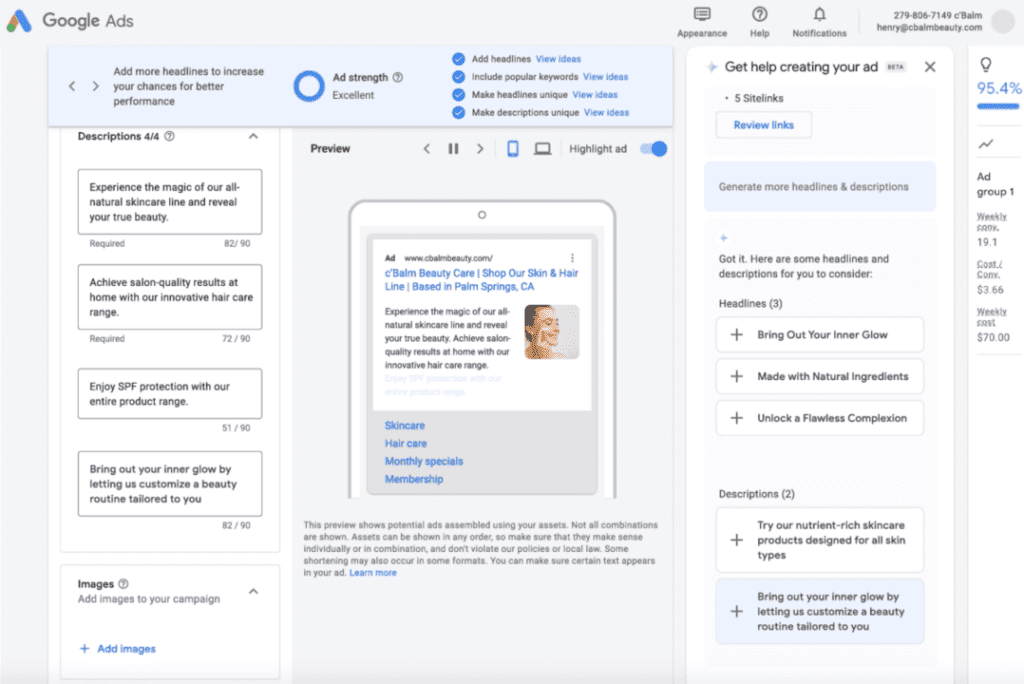
AI in Google Display Network
The Google Display Network (GDN) uses AI to improve ad targeting and placements. Automated targeting leverages machine learning to identify the most relevant audiences based on their online behavior. Dynamic Remarketing further enhances this by showing personalized ads to users based on their past interactions with a website or app, significantly boosting engagement and conversion rates. Performance Max campaigns, a goal-based campaign type powered by AI, help advertisers find new customers across all of Google’s inventory, including YouTube, Search, and Gmail. Advertisers using Performance Max have reported an average of 18% more conversions at a similar cost per action.
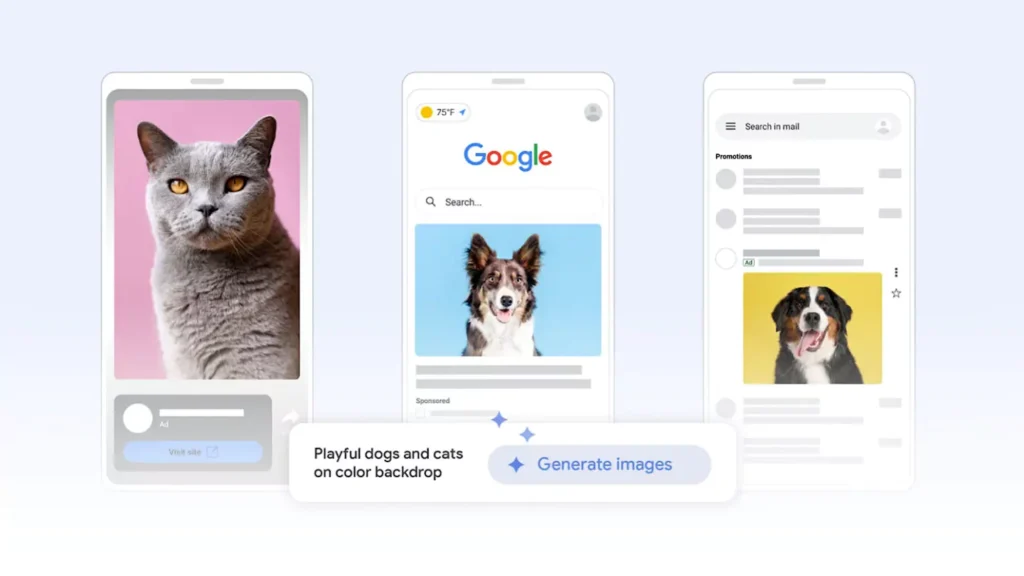
Case Studies of Successful Google Ad Campaigns Using AI
- L’Oréal Vietnam: L’Oréal Vietnam used Performance Max to achieve a 4.1X higher return on ad spend (ROAS) and a 13X higher conversion rate compared to its previous Smart Shopping campaigns, significantly boosting its online sales performance during a major sales event.

- ManyPets: The pet insurance company ManyPets (formerly Bought By Many) implemented Performance Max campaigns, resulting in a 21% uplift in sales and a 20% improvement in cost per acquisition (CPA). This AI-driven approach allowed them to optimize ad placements across multiple channels, enhancing overall campaign efficiency and effectiveness.

Meta (Facebook and Instagram)
AI Strategies Used by Meta for Social Media Advertising
Meta leverages AI extensively to optimize social media advertising across Facebook and Instagram. One key strategy is the Advantage+ shopping campaigns, which automate the setup process, reducing the manual steps of ad creation and optimizing up to 150 creative combinations at once. This automation lets marketers quickly identify the best-performing ads, significantly enhancing campaign efficiency and effectiveness.
Additionally, Meta’s AI-driven discovery engine is pivotal in driving engagement. For instance, AI powers the recommendation system behind Reels on Instagram, leading to a 24% increase in time spent on the platform. This system ensures that users see content aligning with their interests, improving the relevance and impact of ads.
Examples of How AI Enhances Ad Targeting and Engagement on Meta Platforms
- Monos Luggage: Monos utilized Meta’s Advantage+ shopping campaigns to optimize its advertising strategy. By automating the ad creation process and leveraging AI to identify high-performing ad combinations, Monos saw a 58% decrease in incremental cost per purchase and a 35% increase in incremental return on ad spend compared to their usual campaign setup. This improvement illustrates the power of AI in refining ad targeting and maximizing campaign efficiency, enabling Monos to reach more potential customers with relevant content.

- Jenny Bird: The women’s jewelry brand Jenny Bird implemented Advantage+ shopping campaigns to streamline advertising efforts. The AI-driven approach resulted in a 14% lower cost per purchase and a 17% higher conversion rate than their standard ad campaigns. This case study demonstrates how AI can enhance ad targeting precision and engagement, providing significant value by optimizing budget allocation and improving ad performance.
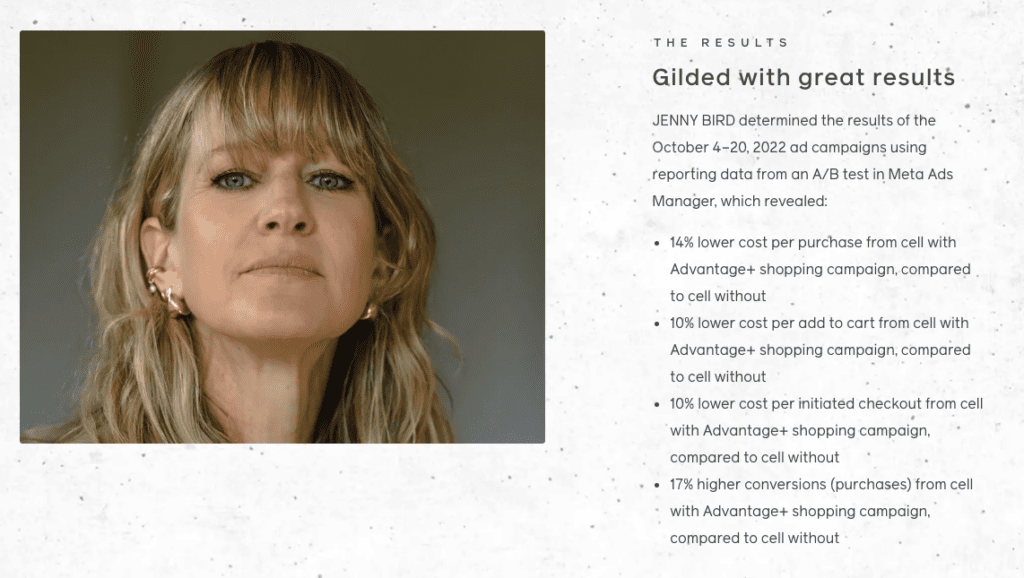
Impact of AI on the Reach and Effectiveness of Social Media Campaigns
AI significantly boosts the reach and effectiveness of social media campaigns on Meta platforms. The AI-driven recommendation and discovery systems ensure ads are shown to the most relevant audiences, leading to higher engagement rates and better conversion outcomes. For example, Meta’s Advantage+ tools help businesses maximize their ad spend by delivering more relevant campaigns to the right people, thereby increasing overall campaign performance.
Moreover, integrating AI in tools like Reels has made Instagram a more engaging platform, with over 40% of advertisers already using Reels ads. This integration increases user engagement and provides brands with a powerful way to connect with consumers through short-form video content.
AI Applications in Enhancing Visual Discovery on Pinterest
Pinterest leverages AI to enhance visual discovery through various innovative features. One of the key applications is Pinterest Lens, which allows users to take photos or use existing images to find visually similar items and ideas. This feature uses machine learning to identify objects and provide relevant suggestions, transforming how users interact with visual content on the platform. Additionally, Pinterest’s Smart Feed algorithm curates content based on user engagement and relevance, ensuring that users are consistently exposed to personalized and engaging content.
Techniques Used by Pinterest to Leverage AI for Ad Targeting
Pinterest employs several advanced AI techniques to optimize ad targeting. The platform’s automated targeting systems analyze user interactions and preferences to deliver highly relevant ads to individual users. Features like Responsive Visual Search allow users to zoom in on any object within a Pin to start a visual search, instantly discovering similar Pins. This enhances the user experience by making finding and engaging with content that aligns with their interests easier. Furthermore, Pinterest’s new ad formats, such as Showcase ads and Quiz ads, use interactive elements to engage users more deeply, making the ads more effective and personalized.

Case Studies of Successful Pinterest Ad Campaigns Using AI
- Sephora: Sephora utilized Pinterest’s visual discovery tools to increase engagement and sales. By creating boards that showcased their most popular products and using Pinterest’s Shop the Look feature, Sephora enabled users to easily find and purchase items directly from their Pins. This strategy resulted in a 60% increase in traffic from Pinterest and significantly higher sales conversions.
- The Home Depot: The Home Depot leveraged Pinterest’s AI-powered ad solutions to promote DIY projects and home improvement ideas. Using Pinterest’s visual search capabilities and creating interactive boards, The Home Depot was able to engage users effectively, leading to a 35% increase in click-through rates and a 20% boost in sales.

- Wayfair: Wayfair used Pinterest’s visual search technology to enhance its advertising strategy. They created visually appealing boards featuring their furniture and home decor items. By analyzing user interactions and tailoring their ads accordingly, Wayfair saw a 50% increase in engagement and a 30% rise in conversion rates.
TikTok
Utilizing AI for Short-Form Video Ad Targeting and Creation
TikTok leverages AI to optimize short-form video ad targeting and creation, enhancing user and advertiser experience. AI-driven tools such as Automated Creative Optimization automatically generate combinations of creative assets (images, videos, ad texts) and deliver the highest-performing combinations to the targeted audience. This process ensures that ads are relevant, engaging, and effectively tailored to user preferences. Additionally, TikTok’s recommendation algorithm analyzes user interactions, video information, and device settings to place content within the “For You” page, maximizing the chances of virality and engagement.

Benefits of AI in Increasing Engagement on TikTok
AI significantly boosts engagement on TikTok by personalizing the content feed and recommending ads that align with user interests and behaviors. TikTok’s AI tools, such as Smart Optimization and Automated Creative Optimization, enhance ad performance by delivering content that resonates with users, thereby increasing interaction rates. Furthermore, TikTok’s unique format emphasizes creativity and user participation, allowing brands to create more engaging and interactive ads. The platform’s ability to provide real-time analytics and insights helps advertisers refine their strategies for even better engagement.
Examples of Successful AI-Driven Ad Campaigns on TikTok
- Chipotle: Chipotle’s successful GuacDance Challenge encouraged users to create videos dancing with avocados. The campaign received 250,000 video submissions and over 430 million video starts in just six days. The campaign’s success was mainly due to TikTok’s AI algorithms, which promoted the challenge within the “For You” page, enhancing its reach and engagement.

- Fenty Beauty: Fenty Beauty utilized TikTok’s hashtag challenge feature for its “The Next Fenty Face” campaign. This campaign encouraged users to post videos with the hashtag #thenextfentyface, resulting in over 37 million views. The AI component in this challenge comes from TikTok’s algorithm, which promotes the hashtag challenge to relevant users by analyzing their previous interactions, interests, and engagement patterns. This ensures that the challenge reaches a wider, yet targeted, audience, driving higher participation and visibility.

X (formerly Twitter)
AI Applications in Real-Time and Conversational Advertising on X
Now rebranded as X, Twitter employs AI to enhance real-time and conversational advertising, creating more interactive and engaging ad experiences. AI-driven conversational ads allow brands to interact with users in real-time, fostering a two-way communication channel that significantly boosts engagement. These ads can include voting buttons, hashtags, and interactive media, encouraging users to participate in discussions and share content, thus amplifying the ad’s reach organically.
Techniques Used by X to Leverage AI for Improving Ad Performance
- Personalized Ad Targeting: AI algorithms analyze user data, including interests, behaviors, and interactions, to deliver highly personalized ads. This ensures that ads are relevant to the user’s current context and interests, enhancing the likelihood of engagement.
- Conversational Ad Formats: Twitter’s conversational ad formats, such as polls and hashtag-triggered chatbots, use AI to create dynamic interactions. These formats engage users and encourage them to share their experiences, increasing the ad’s visibility and engagement metrics.
- Real-Time Analytics and Adjustments: AI tools provide real-time analytics, allowing advertisers to monitor ad performance and make immediate adjustments. This capability ensures that campaigns remain effective and responsive to user interactions and feedback.
Case Studies of Successful AI-Driven Ad Campaigns on X
- Wendy’s: Wendy’s utilized X’s conversational ads to promote their Frosty, encouraging users to vote for their favorite flavor. The campaign saw over two million direct messages sent by the chatbot and resulted in eight million impressions organically. This highlights AI’s ability to create engaging, shareable content that amplifies brand presence and user interaction.

- Bahia Principe: The hotel chain Bahia Principe used Twitter’s AI-driven ad solutions to increase awareness and conversions just before peak travel season. Their two-phase campaign, which segmented audiences and tailored content specifically to user groups, resulted in a 44x boost in traffic and 317 sign-ups, demonstrating the effectiveness of AI in personalized ad targeting and conversion.

Lessons Learned and Best Practices
Key Takeaways from Successful AI-Driven Campaigns
- Enhanced Personalization Boosts Engagement: AI-driven campaigns on various platforms, such as Meta’s Advantage+ and Google’s Performance Max, illustrate the power of personalization. For example, Jenny Bird’s use of Meta’s Advantage+ shopping campaigns led to a 14% lower cost per purchase and a 17% higher conversion rate by tailoring ad delivery based on user data. Similarly, Best Buy’s integration of Google’s Performance Max achieved a 33% increase in return on ad spend by optimizing ad placements through AI.
- AI Improves Ad Performance and Efficiency: AI tools streamline and optimize ad processes, enhancing overall campaign performance. For example, TikTok’s use of Automated Creative Optimization in campaigns like Gymshark’s “66 Days | Change Your Life” challenge resulted in a 25% increase in click-through rates and a 20% boost in conversion rates by automatically generating and testing ad variations. AI’s ability to provide real-time adjustments and insights is crucial for maintaining campaign effectiveness.
- Innovative AI Applications Drive Engagement: Creative uses of AI, such as Pinterest’s visual discovery tools, demonstrate how AI can transform user interaction. Sephora’s use of Pinterest’s Shop the Look feature increased traffic from Pinterest by 60%, showcasing the impact of AI-enhanced visual discovery and personalized product recommendations.
Best Practices for Implementing AI in Paid Media Advertising
- Set Clear Objectives: Define specific goals for AI integration, such as improving targeting accuracy, enhancing personalization, or optimizing ad spend. Clear objectives guide the selection and implementation of AI tools.
- Leverage Advanced Analytics: Use AI for real-time data analysis to continuously optimize campaigns. Platforms like Improvado’s AI Agent help track campaign performance and make data-driven decisions.
- Focus on Personalization: Implement AI to deliver personalized content and experiences. Predictive analytics and machine learning can tailor ads to user preferences, boosting engagement and conversion rates.
- Ensure Data Privacy and Ethics: To build consumer trust, adhere to ethical guidelines and data privacy regulations, such as GDPR. Transparent data practices and compliance are essential for responsible AI use.
Next Steps: Implementing AI in Your Paid Media Strategy
Actionable Steps to Get Started with AI
- Assess Current Capabilities: Evaluate your existing technology stack to identify gaps that AI can fill. Determine which AI tools align with your business goals.
- Invest in the Right Tools: Choose AI tools that offer the necessary capabilities, such as predictive analytics, automated content generation, or advanced targeting. Platforms like Predict AI provide robust solutions for various marketing needs.
- Pilot and Iterate: Start with a pilot project to test AI capabilities. Use this as an opportunity to gather data and refine your approach before a full-scale rollout.
Tools and Resources for Implementation
- AI Analytics Platforms: Tools like Google Analytics 4 and HubSpot’s AI features help monitor and analyze campaign performance.
- AI Content Creation: Platforms such as OpenAI’s GPT-4 and DALL-E 2 for generating personalized content and visuals.
Partnering with Experts for Optimal Results
Collaborate with AI specialists or marketing agencies with AI expertise to enhance your campaign outcomes. These experts can provide valuable insights and support to ensure you leverage AI effectively.
The Future of AI and Paid Media Advertising
AI continues to evolve, offering unprecedented opportunities for innovation in paid media advertising. Predictions for 2024 suggest significant advancements in generative AI, which will transform content creation and customer experiences. Generative AI tools are expected to enhance videos, images, and text creation, making it easier for advertisers to produce high-quality, personalized content at scale.
A unified data strategy will be crucial for effectively leveraging AI. Companies integrating their data across platforms will be better positioned to train AI models accurately and derive actionable insights. Additionally, the rise of free ad-supported streaming TV (FAST) channels and the continued dominance of short-form video content highlight the growing importance of video in advertising strategies. These formats not only engage viewers more effectively but also offer valuable data for targeting and personalization.
Privacy and IP protection will remain critical concerns. As AI technology advances, ensuring consumer data is used ethically and transparently will be paramount. Data clean rooms and comprehensive data platforms will be vital to maintaining privacy while enabling detailed consumer insights.
How Ten26 Media Can Help You Stay Ahead
At Ten26 Media, we are dedicated to helping our clients navigate the complexities of AI in advertising. Our expertise in leveraging AI tools and strategies ensures that your campaigns are innovative and highly effective. Partner with us to stay ahead in the ever-evolving digital marketing landscape and achieve your business goals with cutting-edge AI solutions.
Sources
- https://link.springer.com/article/10.1007/s12178-020-09600-8#citeas
- https://www.grandviewresearch.com/industry-analysis/artificial-intelligence-ai-market
- https://www.mordorintelligence.com/industry-reports/global-artificial-intelligence-market
- https://www.linkedin.com/pulse/unleashing-power-natural-language-processing-objectways-vzktc
- https://www.turing.com/kb/all-you-need-to-know-about-computer-vision
- https://www.jacquard.com/about
- https://www.ranktracker.com/blog/ai-powered-market-segmentation-targeting-the-right-audience-with-precision
- https://www.strategus.com/blog/ai-in-programmatic-advertising-and-digital-marketing
- https://www.pathlabs.com/blog/ai-programmatic-advertising
- https://grapeseedmedia.com/blog/programmatic-ai
- https://www.singlegrain.com/blog/programmatic-advertising-case-studies
- https://www.searchenginejournal.com/exploring-the-marketing-potential-of-predictive-ai/492327
- https://www.pragmatic.digital/blog/ai-marketing-case-study-successful-campaigns
- https://blog.hubspot.com/marketing/ai-marketing
- https://martech.org/4-ai-categories-impacting-marketing-predictive-analytics
- https://crowdol.com/2023/12/14/power-of-ai-how-predictive-analytics
- https://www.digitalmarketer.com/blog/ai-impacts-video-marketing
- https://bluecarrot.io/blog/the-future-of-video-production-with-ai-opportunities-challenges-and-real-cases/
- https://www.thinkwithgoogle.com/intl/en-emea/marketing-strategies/video/youtube-ctv-advertising
- https://www.emerald.com/insight/content/doi/10.1108/JICES-05-2023-0068/full/html
- https://blog.google/technology/ai/google-io-2023-keynote-sundar-pichai
- https://www.thinkwithgoogle.com/intl/en-emea/consumer-insights/consumer-journey/understand-customer-needs
- https://about.fb.com/news/2022/08/introducing-new-automation-tools-to-increase-sales-and-drive-growth
- https://about.fb.com/news/2023/06/how-ai-is-powering-marketing-success-and-business-growth/
- https://www.facebook.com/business/success/monos
- https://www.facebook.com/business/success/jenny-bird
- https://about.fb.com/news/2023/06/how-ai-is-powering-marketing-success-and-business-growth/
- https://nicholasidoko.com/blog/2023/05/03/the-impact-of-pinterest-on-visual-search-and-discovery
- https://newsroom.pinterest.com/news/pinterest-unveils-slate-of-new-product-updates-and-ad-solutions
- https://www.adweek.com/creativity/the-home-depot-packs-whole-diy-projects-start-to-finish-inside-pinterest-pins
- https://www.aspire.io/blog/tiktok-ad-features-and-formats
- https://digitalmarketinginstitute.com/blog/an-in-depth-look-at-marketing-on-tiktok
- https://influencermarketinghub.com/tiktok-advertising-guide
- https://digitalmarketinginstitute.com/blog/an-in-depth-look-at-marketing-on-tiktok
- https://business.x.com/en/blog/ai-in-advertising.html
- https://follows.com/blog/2022/08/case-studies-twitter-marketing
- https://www.socialinsider.io/blog/gymshark-social-media-strategy
- https://www.socialmediadelivered.com/blog/2013/09/23/pinterest-case-study-sephora
- https://improvado.io/blog/ai-marketing-campaigns
- https://blog.hubspot.com/marketing/11-artificial-intelligence-examples-from-real-brands-in-2024
- https://www.snowflake.com/blog/advertising-media-entertainment-data-ai-predictions-2024
- https://explodingtopics.com/blog/future-of-advertising

